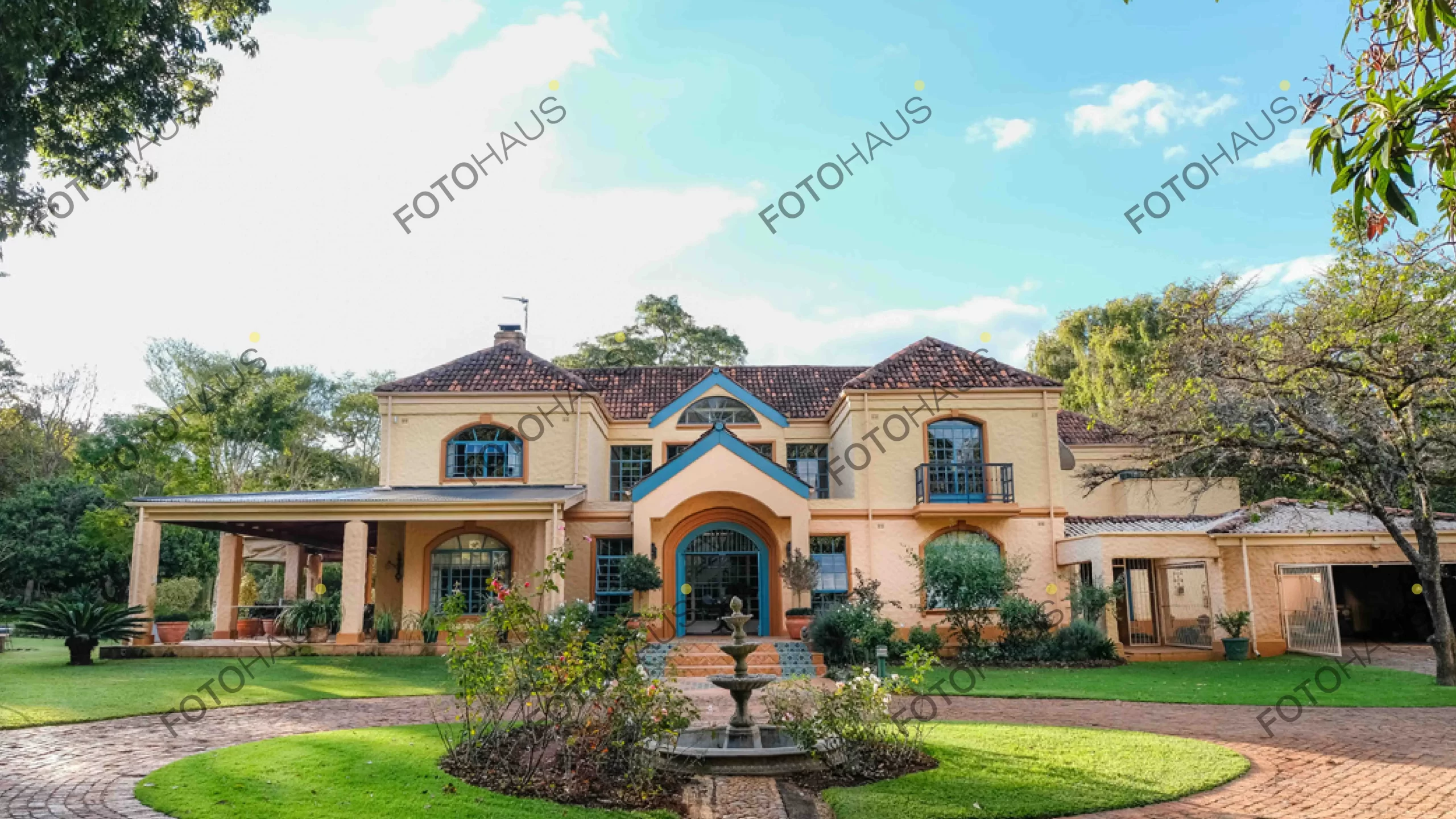This extraordinary and unique house in Harare looks like it’s been magically transported from the hills of Tuscany. It’s apparent that there’s more than just a touch of enchantment about this superb family home. The house was built by a gentleman named Mike McNaught, who later left Zimbabwe for Cape Town. After he left the country the house had two previous owners before the current owners bought it – so they’re the fourth owners – and they’ve been lucky enough to live there for the last 12 years.
Even the history of the house is slightly mysterious. No-one knows who the original architect was or exactly which year the house built. Obviously McNaught was a well travelled man and had spent some time in the Mediterranean but no-one knows what inspired McNaught to build such an amazing and striking family home which is truly one of a kind. A Mediterranean marvel set in the middle of Africa! Although the front facade is very imposing – a formal and symmetrical double storey structure – it still manages to be both charming and welcoming. It has that comfortably weathered look so typical of old Mediterranean villas which like fine wines, improve and mature with age.
The approach to the house is down a long secluded driveway and the house only comes into view after the last bend, so it’s a delightful surprise when the house is finally revealed. There’s a circular brick cobbled driveway in front of the house complete with a water feature and white roses and lavender bushes. A walkway of terracotta tiles with inset blue mosaics leads up three wide steps to the arched front doors which are flanked by potted olive trees. There’s a small portico over the front doors and a romantic Juliet balcony peeps out on one side. (There are another three small Juliet balconies at the back of the house.) The exterior colours perfectly complement the architectural style and character of the house.
The textured walls are painted a sort of biscuit/ sandstone colour with hints of pink and orange – a colour that changes subtly all the time as the light alters throughout the day. A darker toned honey colour highlights the architraves and architectural details. Window frames, door frames and fascias are picked out in a gorgeous sky blue which repeats the colour of the mosaic tiles at the entrance. The roof is clad in hand made clay tiles which really define the personality of the building. Presumably the roof tiles were specially imported from Italy as this type of tile has never been manufactured here.
Although the roof tiles are very beautiful they have also proved to be a bit problematic. Because each tile is ever so slightly different, being handmade, they are prone to leaking and they’re also very heavy. The roof of the large verandah which runs partially around three sides of the house was leaking badly. New replacement tiles were obviously impossible to source locally. There was an asbestos ceiling under the verandah roof which was hidden behind swathes of hessian burlap of the type used for tobacco bales. According to the owners, “It looked fabulous until the leaks started showing!” Eventually the owners resorted to calling in Liz Howes from Howes and Homes to replace the entire verandah roof section.
Howes and Homes installed a new Chromadek roof with a tongue and groove ceiling underneath, and the problem was solved. The natural colour of the tongue and groove timber has been retained so it blends well with the colour of the exterior walls and adds a kind of rustic charm. The verandah has the most African inspired decor with a collection of colourful ethnic baskets on the wall and woven wicker furniture. A simple wrought iron pendant light with matching wall sconces completes the look. The main seating area overlooks the pool while tucked around the corner is an informal dining area for al fresco entertaining.
The verandah links the house to the lush park like gardens and the pool. A rather formal terracotta tiled walkway leads to a small water feature and on to the pool. Although the pool was existing when the current owners moved in the area around the pool needed to be retiled. The tiles around the pool, the insets in front of the verandah, and the mosaic tiles at the entrance were all supplied by the late Colleen Meyburgh from Burnt Earth.
The terracotta flagstone tiles continue from the verandah and lead into the main formal lounge through double French doors. Most of the house, apart the bedrooms, has the same floor tiles – left natural outside but polished inside to a delightful aged patina. The lounge has pressed metal ceiling panels hinting that the house was perhaps built in the 20’s or 30’s when this type of ceiling was popular. There’s a large and quite formal fireplace with a mirror above which is an original feature of the house.
The room is decorated with big comfy sofas, antique cabinets and Persian rugs. Like the exterior most of the interior walls are textured bag washed plaster which together with the rough floors and pressed ceilings gives the home a warm sense of history. The lounge leads into the formal dining room which has quite grand proportions. An antique dining table with seating for eight sits comfortably in the room and leaves ample space for cabinetry and even a small chess table with matching spindle chairs. The walls are painted a deep wine red and hung with several large artworks which add to the opulent baronial ambiance.
Tucked away behind the dining room is the fairly modest kitchen which although small has everything necessary – including a rather elaborate hood over the hob – and even a small breakfast nook. Several service rooms lead off the kitchen so all the clutter is hidden away But by far the most unusual and breathtaking feature of the house is the central double height atrium which is really the heart of the home. It’s so dramatic and theatrical it looks like part of a stage set for an elaborate opera! It’s the first thing you see when you enter from the front door and it links all the different wings of the house on both floors. It fills the interior with natural light during the day and in summer it keeps the house deliciously cool. It’s a roughly square structure of approximately four metres on each side with glassed paned walls and it opens to the sky.
While it’s stunning on a sunny day it must be a truly spectacular sight during an evening thunderstorm with lightning flaring overhead. It also serves to separate the front foyer from the rest of the house and conceals the main staircase from the entrance. The staircase, which has charming, fairly simple, metallic blue balustrades and wooden handrails, runs up behind the atrium to the first floor. At the top of the stairs is a generous landing/foyer which currently serves as a study with a view onto the atrium.
Above the stairs the timber trusses are exposed and the ceiling follows the roof angle, so it creates a very special space which feels a little like the inside of an old sailing ship or perhaps a church. A really clever design feature of the landing is the built in cupboards which are usually fairly dull. Here the cupboard fronts have been made from old wardrobe doors with mirrored centre panels fitted into a wooden frame. It’s an innovative and creative way to transform the ordinary into something quite special.
The master bedroom suite leads off to one side, while there are also two bedrooms with a shared bathroom and an additional two guest bedrooms. The master bedroom has one of the Juliet balconies at the back of the house and gorgeous views over the garden. It also boasts the most lavish dressing room complete with a chaise longue and vanity area. The master bathroom leads off the dressing room and has a corner bath, a unique shower with windows onto an enclosed courtyard and a small, private outdoor space.
Text by Michael Nott
Photography by Michele Fortmann

